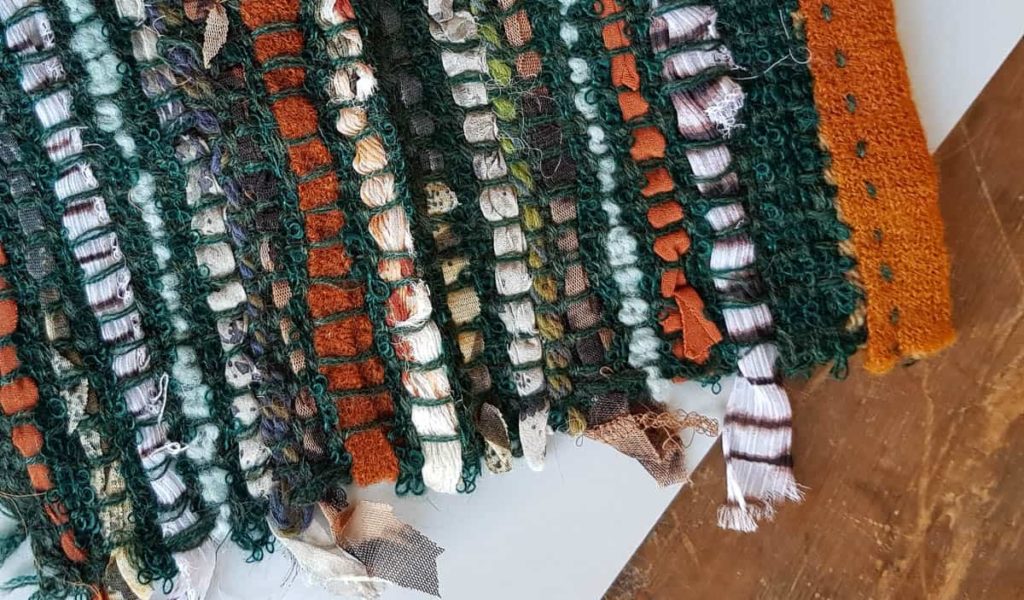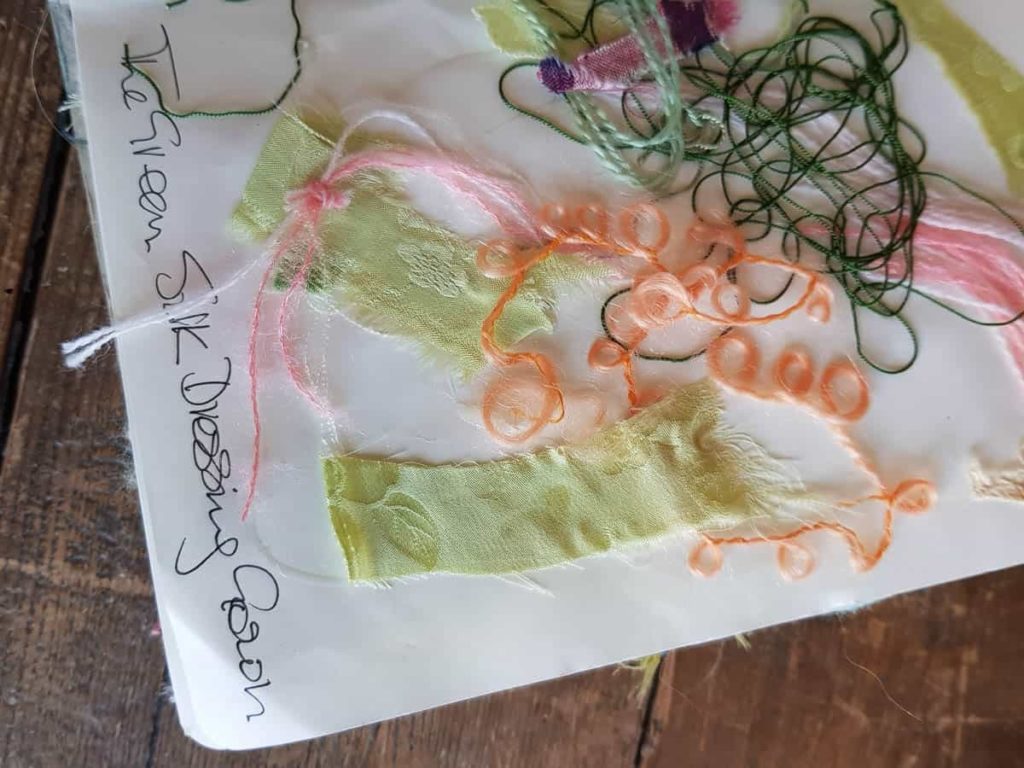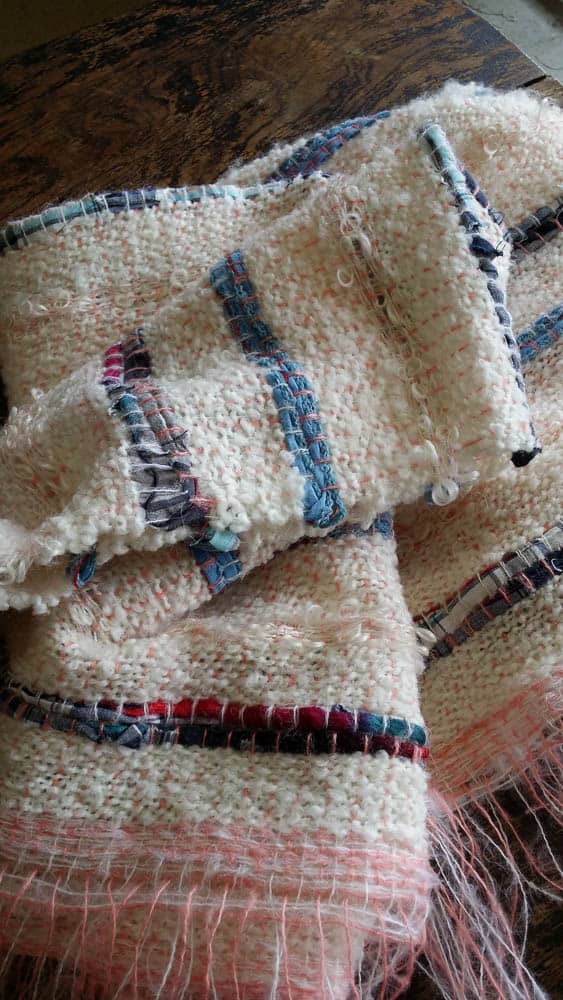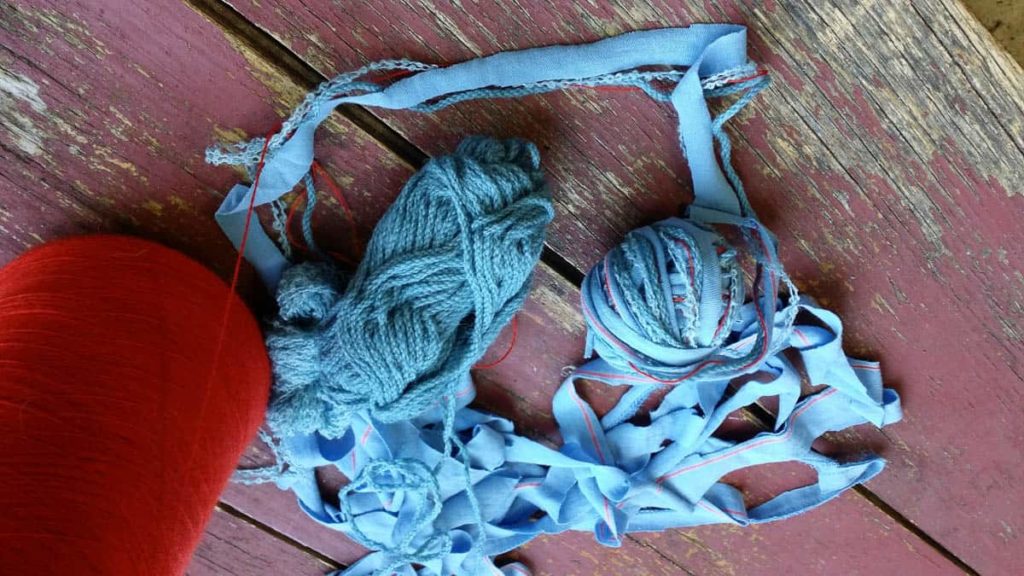- Mary Burgess, 201,7 The Dancing Skirt, design paper, silk, wool, cotton.jpg
- Mary Burgess, 2017, Mother baby rug, sample wool, cotton, mohair, polyester 17 x 24cm
- Mary Burgess, 2018, presentation cardboard, tissue, silk and cotton
- Mary Burgess, 2014, The Greeen Silk Dressing Gown beginnings silk, mohair, cotton and wool
- Mary Burgess, 2015, The Grandpa Rug Just Off the Loom wool, cotton, mohair dimensions 90 x 70cm.jpg
- Mary Burgess, 2015, The Grandpa Rug Shirt, thread cotton and wool
Meeting with J for the first time today. She seemed both crumpled and dogged. The connection between us to make this meeting happen was like a thin and fraying thread that might break at any moment. But she persisted and she found her way to my studio. She told me her husband died less than a month ago. She wondered if it was too soon to talk to me about what I do. Tears came. She wants two baby blankets and a bedspread made with her husband’s clothes. She was decisive about this.
✿
I am a hand weaver. My father managed a textile factory in the 1940’s and 50’s. They made nylon stockings that came in individual boxes, and designed and wove daring post-war furnishing fabrics. I grew up with fabric samples on the kitchen table. I first used a loom at school. Weaving kept inserting itself into my life, till I accepted it. Now making cloth is an act I love so much I continue to be mystified by the joy I experience.
✿
I work with dead people’s clothes. I transform them through weaving. My business is called Woven Memories. When someone dies in a family their clothes survive them. Sometimes there is an efficient cleaning out of the house, including the clothes. But many people keep one or two items or never get round to the clean out, or put it all in the garage. These clothes sit in drawers, boxes and cupboards, at times like a silent reproach, or offering an intense jolt of memory, a sudden wave of love or sadness when rediscovered. I work with people to transform these textiles, to hold onto them in new ways. It is a carrying of threads and cloth fragments from the past into the future. My focus is the transformation.
✿
When I first started this process I wove for myself. After my partner died I used his clothes, our sheets, the jacket I wore to his funeral, furnishing fabric from his dining chairs, even a hospital pillow case that came home with him after his last stay in hospital—accidentally dyed pink. I wrote down these questions before I started:
- What is being remembered?
- What is being held?
- What is the work of mourning?
- What is building the future?
- What is the shape to go ahead with from here?
- What is it for?
- When is it for?
I had very little sense of the answers to these questions. These are still my questions. Each time I first meet with someone and their family clothes I have no sense of the answers at the beginning. They must emerge through the process of talking, preparing, designing, sampling and making. I must always stumble in the dark to get started.
✿
I need to find my own connection to the person who wore these clothes that sit in a pile in front of me. I do something akin to inhabiting the clothes in order to make something that holds elements of the spirit of the person. I feel their texture. I smell them. I read the labels. I wonder where they were made, where they were bought, occasions on which they were worn. Then I write myself some little notes. Sometimes I share these with my client at the end of the process, but not always. I need to be able to think and write about the person who wore the clothes on my own terms. I never put on the clothes.
✿
Not many people I have worked with are up for the task of destroying a garment themselves. I don’t push it. But I do believe that if someone can cut or tear into their mother’s scarf, or their father’s shirt, then something intangible and beyond words takes place. Unravelling a jumper is somehow easier, but with it can come an unravelling of the story one tells oneself about a family member, revealing deeper, more complex, painful truths.
✿
Cutting into the fabric of a piece of clothing has an intense finality to it. The first cut or tear signals an ending akin to death. I feel heaviness in my stomach. The person who went out into the world in this garment really has gone. They will never wear it again. No-one will wear it. Something is in the process of vanishing completely. I like to do this alone and in complete silence. It gets easier after that. I make the first transition. I begin to experience the cloth turn into a strip of fabric, a ragged thread of sorts that I will weave with. As I continue to tear or cut, the experience of the destruction of the shirt or jacket sits more in the background. I gradually move to focus on the process of tearing and cutting in its own right.
✿
Sometimes I ply the cloth strips with one or two wool, cotton or silk threads so it is almost disguised, a new yarn in fact. I like the idea of my client having the secret knowledge that this blanket or scarf contains precious fragments from the past, but they don’t need to reveal this. It shouldn’t necessarily be obvious.
✿
The starting point is when someone arrives and sits in front of me with clothes they have chosen to be woven into something new they will cherish and keep. This first stage is an enquiry, a listening process, a focus on the stories of the lost family member and their life. I am listening for “why these clothes?”, “what is being asked of this process?”. Always there are two things happening simultaneously. The discussion of the possible new woven item sits on the surface. Running parallel beneath the surface is the question of what is being linked to and potentially transformed psychologically for my client as we work.
✿
I begin to design the new piece through little woven samples. My question is how the materiality of the clothes speaks to me about the person who died. I put to one side whatever biography I have heard. Whether I am intuiting or imagining during this process I can never know. I write down these thoughts. In one project I imagined a pretty woman with a clear style, both soft and sculptural. But what kept coming into my head were thoughts about her marriage being in difficulty. I will never know, but there was some sense of a well-hidden vulnerability. I aimed to bear witness to her life and my thoughts about it as I cut and tore and wove. I wanted some sense of both her style and her vulnerability to come through in the new fabric.
✿
Halfway through making my own blanket I wrote:
“Can this rug I am making somehow hold a kind of morphic resonance – all that the relationship held for both of us? Weaving our dreams, love, conversations, pain, disappointments and loss together forever – or at least for the duration of my life.“
Do scraps of fabric have magical powers, or protective powers maybe? Certainly, the Balinese double ikat gringsing weavings are considered to ward off disease and reduce pain.
✿
My client L wrote to me and said she felt she was wrapping her baby in her mother’s love. For her, her mother’s love is held in the strips of fabric created from a skirt, a blouse, and a jacket. In the same way, my partner’s shirts are woven into my blanket that I wrap around me when I sleep. It is as if I can call on his strength, sanity and moral compass, as if something of him lies over me, both seeping into me and protecting me through the fragments of his clothing. I think there is something important in these experiences of the threads from the clothes once worn and now woven into a new textile. A transformation does take place, but something essential is retained.
✿
There’s another transition in me as I start to weave. I wind the strips of fabric knotted together to make a long thread around a stick shuttle. The thing with weaving, and probably many other making processes is that one never knows what the newly created piece of cloth will be like till it is woven. I sample for a look and feel that is both what my client wants and how the weave can represent the person who wore the clothes. Sometimes it is a co-creation with my client where it is truly a design that emerges out of conversation and sharing of ideas. Other times I am left to do this on my own.
✿
I sit on a long wooden hinged bench to weave. It has a little box at the end to hold my tools: my scissors, snips, threading devices, a darning needle and pins to mend broken warp threads. My favourite loom sits in front of this bench. It is a beautiful piece of furniture made of silky oak. It is what is called a counter marche floor loom. I move the warp threads up and down by pushing foot pedals. I weave the weft of torn fabric on stick shuttles. I don’t wear shoes to weave. This loom has been mine for nearly fifty years, but it is much older. It is one of the first fifty looms made for the War Widows Craft Guild in Australia between 1940 and 1950. One like mine sits in the National Museum Australia. It feels like the perfect loom to be doing this work I’ve chosen. I wonder about the women who wove on my loom before me and what states of grief it has witnessed other than my own.
✿
“Some objects feel like nouns… Other objects feel contingent on the world around them.” Edmund de Waal
I give a name to each Woven Memories project. Sometimes it is about the clothing I am working with—”The Delft Gown, ‘The Dancing Skirt”, “The Red Dress”. In these there is an emphasis in my mind about the history, the stories, the lived experience of the garment and its wearer. These are often in some way exceptional garments in their own right. They can seem flamboyant, suggesting exciting events, travel, or a time of great joy. By contrast, faded shirts that arw worn and washed many times or old hand knitted jumpers speak more of daily life. They seem to offer a blank slate on which one can impose a functional name clearly linked to a future purpose such as “The Grandpa Baby Rug”, “The Mother Cushion”. These are my private names for each project. The naming process somehow centres me in the work. The name creates a kind of frame around what I am wordlessly trying to achieve through the weaving. Without these names, I think I would find myself weaving cloth that has no purpose, somehow adrift in the making.
✿
Cloth, as it is being woven, is rolled onto a beam at the front of the loom. The finished work can only be seen in its entirety as it is unrolled from this beam. There is an almost mournful squeaking from my loom as the roller is turned to reveal the cloth as if it is reluctant to give up its secrets.
✿
A piece of weaving just off the loom is naked, not yet an object, not finished, not held together tightly enough. Threads must be tied or sewn to stop the cloth from unravelling. Wool blankets are ‘wet finished’ either by soaking in water or washing. This process tightens the interlacing of the threads and yarns, turning a piece of weaving into a fabric. The fabric is then further worked to become a new garment, a bag, a rug, a mat. Very fragile weaving can be sewn onto a backing cloth and become a framed artwork. All these processes transition the original textiles away from their past life. They become an essential part of the transformation into a new cloth, and then a new object.
✿
Right now on my work table, I have a rolled up two-metre long silk table runner, recently finished. It will grace a family dining table. It includes a magnificent silk scarf in purple, oyster, lime and rose colours. It has been torn up and woven. Strips of the scarf are now mixed with other silks to mirror the colour scheme. The scarf belonged to the grandmother of the family. Like other completed projects it seems to have a kind of pent up waiting presence. It is fully formed into a new object with a new function. It seems to shimmer in readiness for its new purpose. But the resonance of the past is there in the fibres. This piece will offer something tangible and symbolic, known and emergent for the family who will use it.
✿
I make a small ceremony of the last transition, the delivery of the new woven piece to my client. I finish the small black book I offer as a detailing of the process. I then collect sheets of black tissue paper from it’s store place under my bed, and make a shiny black box to enclose the piece. The little book documents my thoughts, holds some of the woven samples, threads and photos—sometimes from the family—and has space for my client to write their own reflections. The wrapping and boxing up I believe are very important. It is a layering of protective coverings. I want to slow down the revelation of the transformed garments, so that the sense of anticipation and wonder can be savoured. This can be an unpredictable and intensely emotional moment, incredibly sad, or unexpectedly joyful, and bitter sweet at times. It represents both an ending and a beginning.
✿
I am not offering therapy or counselling. I listen, create, weave and hand over the finished product. I do not set out to fix or change grief. However, some kind of re-construction of the relationship to the person who died seems to take place for some people I work with. L wrote at the end of our work together ‘I now understand my father, I forgive him’. What I observe is some kind of internal process mirroring the external transformation of the clothing of a loved one. Initially, there is a deconstruction, a not knowing place where all that exists is the torn apart strips. The future for these threads can barely be hoped for, let alone imagined. It occurs to me that it may well be very important to invite my clients to weave some of the strips, to be an active participant in creating the future in a tangible way. Whatever does or does not take place emotionally for my client there is a focus in my work on holding a space for the new to emerge at every level.
✿
There is an ending for me too. I’ve lived with the spirit of the dead person through their clothes. I am also letting go of my own kind of knowing of someone. I wonder how memories of the lost mother, brother or father will now be held. This linking object may or may not be the vehicle for further transitions in my client and their wider family over time. This is something I cannot ever truly know or witness.
✿
Further reading
Claire Pajaczkowska “Tension, Time and Tenderness: Indexical Traces of Touch in Textiles”, chapter in The Handbook of Textile Culture, J. Jeffries, D. Wood Conroy, H. Clark, Bloomsbury Publishing 2015
Beverly Ayling-Smith Cloth, Memory and Mourning
Emma Peters The Mnemonic Qualities of Textiles
Author
 Mary Burgess is a hand weaver with a focus on mourning. She runs the Woven Memories project from the Nicholas Building in Melbourne, Australia. Mary recently partnered with Hong Kong University Social Work Department researching the impact of handweaving on grief and has twice been Artist in Residence in Australian hospitals. She is currently designing and weaving small woollen blankets for families to use when their baby dies.
Mary Burgess is a hand weaver with a focus on mourning. She runs the Woven Memories project from the Nicholas Building in Melbourne, Australia. Mary recently partnered with Hong Kong University Social Work Department researching the impact of handweaving on grief and has twice been Artist in Residence in Australian hospitals. She is currently designing and weaving small woollen blankets for families to use when their baby dies.







